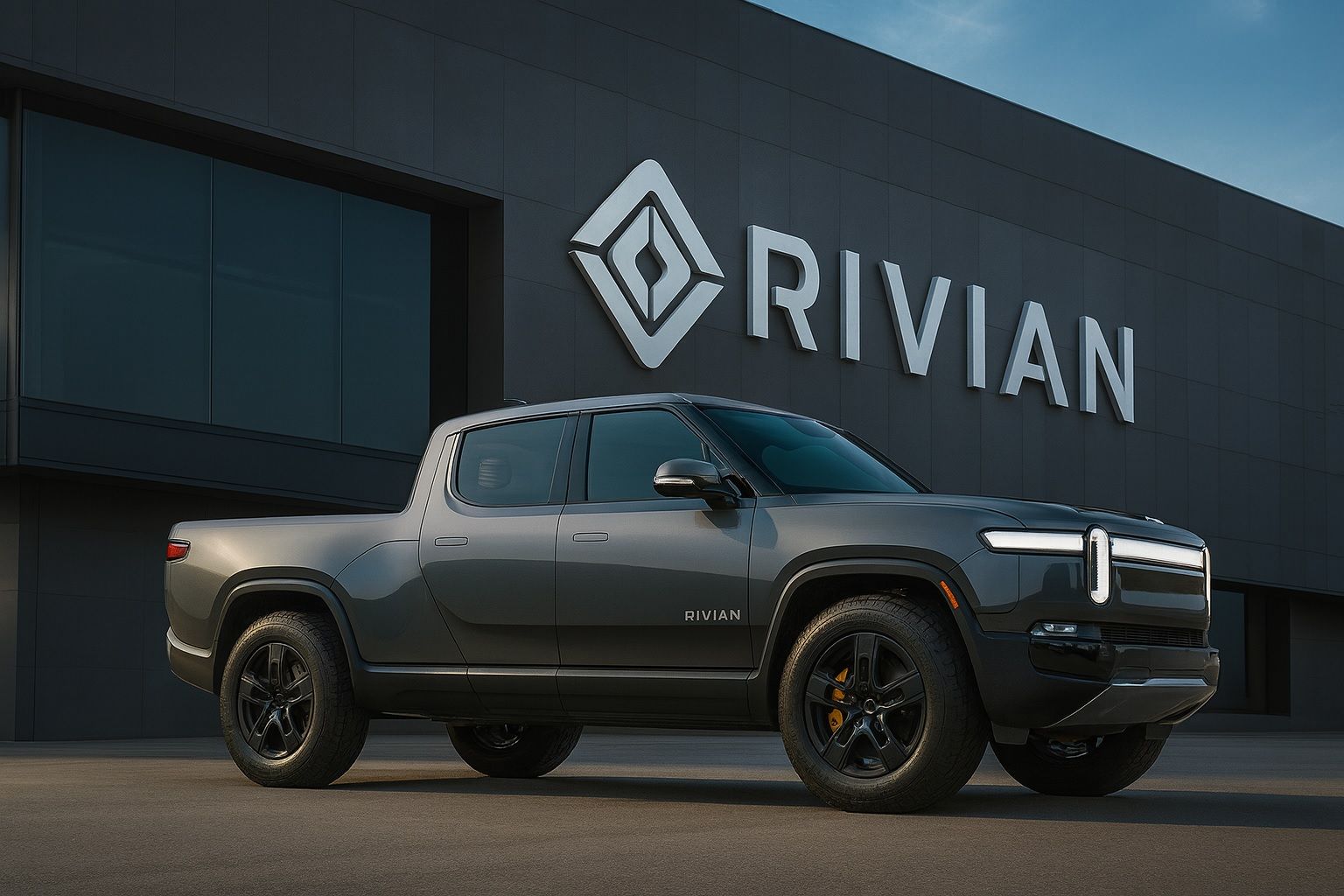- Major Layoffs: EV truck maker Rivian is cutting over 600 jobs (roughly 4% of its workforce) in a second round of layoffs in two months [1] [2]. The latest cuts mainly target sales and service staff as the company faces cooling demand [3].
- EV Demand “Pullback”: Rivian’s cuts come amid a broader electric vehicle slowdown. A key $7,500 federal EV tax credit expired last month – driving up prices and denting demand for EVs [4]. Ford’s CEO even warned U.S. EV market share could fall from ~10% to ~5% without incentives [5], underscoring industry jitters.
- Cost Pressures Rising: The automaker also blames higher costs from new tariffs. CEO RJ Scaringe told investors that Trump administration tariffs have created a “complex and rapidly evolving” policy environment, forcing Rivian to slash its 2025 profit outlook [6]. Rivian now only expects to break even on a gross profit basis next year, down from a modest profit forecast [7].
- Stock Under Pressure:RIVN shares have tumbled about 43% in 2025 [8] and sit near $13 after a ~18% drop since late September [9]. Wall Street sentiment is wary – Mizuho’s Vijay Rakesh downgraded Rivian stock to “Underperform” with a $10 target, warning that “slowing EV demand and the expiry of U.S. government incentives” will hurt growth [10].
- Expert Reactions & Outlook: Analysts say all EV makers are feeling the pinch. Even giants like GM took a multi-billion dollar write-down on their EV business this quarter amid weaker sales [11]. CNBC’s Jim Cramer advises investors to “avoid buying Rivian now” due to its heavy spending and cash burn [12]. Rivian is banking on its cheaper R2 SUV (due 2026) to reignite growth, but will likely need more capital to fund new factories and reach profitability [13] [14].
Rivian Cuts 600 Jobs Amid EV Slowdown
Rivian Automotive confirmed plans to lay off around 600 employees as it grapples with a slowdown in electric vehicle demand [15]. The cuts represent roughly 4% of Rivian’s workforce and predominantly affect its commercial teams, including sales and service staff [16]. This move marks Rivian’s second round of layoffs in as many months, following a smaller 1.5% staff cut in September. According to The Wall Street Journal (which first reported the news), the company is trimming headcount to reduce costs and “align resources” with a more cautious market outlook.
These layoffs underscore how even well-funded EV startups are not immune to the sector’s slowdown. Rivian – known for its R1T electric pickup and R1S SUV – had been in rapid growth mode but is now tapping the brakes amid softer sales. The company said affected employees will be eligible for rehire and encouraged to apply for other roles [17], signaling that Rivian hopes to resume hiring once conditions improve. It did not specify which locations were cut in this round. Notably, Rivian is still moving ahead with key projects (like its upcoming R2 model and a new Georgia plant) even as it tightens belts – reflecting a delicate balance between cost-cutting today and expansion for tomorrow.
Tax Credit Cliff Weakens EV Demand
A major factor behind Rivian’s retrenchment is the sudden drop in EV demand after the phase-out of government incentives. At the end of September, a $7,500 U.S. federal tax credit for new electric vehicle purchases expired, effectively making EVs more expensive for consumers overnight [18]. This “EV credit cliff” triggered a rush of sales in Q3 but is now leaving a void in Q4. Automakers big and small are warning of a pullback: Ford CEO Jim Farley has cautioned that without subsidies, EVs could soon shrink to just ~5% of the U.S. auto market (down from ~10% now) [19].
Rivian saw this coming. The company delivered a record ~13,200 vehicles in Q3 2025 – a 32% jump year-over-year – fueled in part by customers racing to buy before incentives lapsed [20]. But even as deliveries climbed, Rivian trimmed its full-year delivery forecast to 41,500–43,500 vehicles (down from a prior 46,000 high-end target) [21]. Executives essentially acknowledged that demand beyond the subsidy boost isn’t growing fast enough to hit earlier goals. With tax credits gone, Rivian and its rivals now expect a much “softer” market in the coming months, as one analyst put it, unless new incentives or steep price cuts can lure more buyers.
Tariffs and Costs Squeeze Margins
It’s not just waning sales worrying Rivian – rising costs are also biting. The company has explicitly pointed to renewed import tariffs on EV components (enacted under the Trump administration) as a strain on its finances [22]. “While we believe deeply in the long-term value drivers of our business, the policy environment continues to be complex and rapidly evolving,” Rivian CEO RJ Scaringe told investors in August, referring to these tariff headwinds [23]. Such tariffs on batteries and other parts add a “couple of thousand dollars” to the cost of each vehicle, according to Rivian’s finance chief – squeezing profit margins across the EV industry [24].
In fact, back in August Rivian lowered its 2025 outlook from a small gross profit to roughly break-even because of these higher costs [25]. The company is scrambling to blunt the impact – for example, by localizing its supply chain and securing domestically produced batteries. It secured a $1 billion investment from Volkswagen earlier this year to co-develop EV technology and also landed a $6.6 billion U.S. government loan to restart construction of its Georgia factory [26] [27]. Those moves should eventually reduce expenses. But in the near term, Rivian and other EV makers are in a high-stakes race to drive down costs as expensive materials and trade policies make each vehicle pricier to build [28].
Wall Street Reaction: Stock Slips and Downgrades
News of Rivian’s belt-tightening comes as its stock has been under heavy pressure. RIVN shares have plunged roughly 43% year-to-date [29] and were hovering around $13 this week – down almost one-fifth from late-September highs [30]. The layoff announcement didn’t spark a huge selloff (shares dipped only about 0.5% on Thursday) [31], but investor sentiment remains bearish. Many see the job cuts as a necessary adaptation to new market realities rather than a sign of strength.
Several analysts have recently cut their outlook for Rivian. Notably, Mizuho’s Vijay Rakesh downgraded the stock to “Underperform” with a $10 price target – predicting another ~23% downside. He warned that “slowing EV demand and the expiry of U.S. government incentives” will constrain Rivian’s growth in the near term [32]. Other Wall Street firms echo that caution; for example, analysts at Cantor Fitzgerald and CFRA also scaled back their projections for Rivian, citing the tougher EV sales environment.
Even some high-profile market commentators are advising restraint. CNBC’s Jim Cramer recently told investors to “avoid buying Rivian now” given its hefty cash burn and the uncertain EV outlook [33]. Despite having over $5 billion in cash on hand, Rivian is spending aggressively on new models and facilities – which could force it to raise additional capital if revenues don’t ramp up. In fact, the company has hinted it may seek strategic partners or fresh financing in the next year to bolster its balance sheet. Such a move could dilute existing shareholders if Rivian issues more stock, a risk the company acknowledges.
Industry-Wide EV Reset
Rivian’s struggles are not happening in isolation – the entire electric vehicle sector is facing a reality check in late 2025. After years of hype and rapid growth, sales have started to plateau for many EV makers, especially at the higher end of the market. Established automakers are also hitting speed bumps: General Motors just took a multi-billion dollar write-down on its EV business in the third quarter, essentially acknowledging that its electric models haven’t sold as expected [34]. Ford has reportedly dialed back its EV production plans and rolled out special lease programs to “extend” the old tax credit for customers, underscoring that automakers expect a slump in EV demand ahead [35]. “In this tougher market, every EV maker – from giants to startups like Lucid and Fisker – is feeling the pinch,” noted a TechStock² analysis of industry trends [36].
Even the market leader Tesla has shown signs of strain. Tesla logged record deliveries in Q3 2025 (nearly 500,000 vehicles globally, +7% YoY) thanks to end-of-quarter discounting and incentive boosts [37]. But the company warned of a possible sales “bust” in Q4 now that those incentives have vanished [38]. As one fund manager observed, the tax credit “definitely…pulled forward demand” into Q3 and could leave a gap in U.S. EV sales in the fourth quarter [39]. Other analysts echoed that view, predicting a “soft couple of quarters” ahead for the EV market [40]. All of this spells a more cautious outlook for the sector. Investors and executives alike are coming to terms with the fact that EV adoption – while still growing year-over-year – may not follow a straight-line trajectory without continued government support or significant cost reductions.
Rivian’s Path Forward
Facing these headwinds, what’s next for Rivian? The company is far from giving up on growth. It’s pressing ahead with development of the R2, a midsize SUV slated for early 2026 that will be Rivian’s most affordable model yet (around a $45,000 starting price). Hundreds of pre-production R2 vehicles are already testing on roads [41], and CEO RJ Scaringe is banking on the R2 to dramatically expand Rivian’s reach beyond the ~500,000 premium customers that its current R1 models target. Analysts estimate the total market for Rivian’s vehicles could jump to as many as 8–10 million buyers once the cheaper R2 and its sibling R3 crossover arrive, up from ~500,000 for the high-end R1 lineup [42]. In other words, moving downmarket could boost Rivian’s volumes by an order of magnitude if executed well [43].
Rivian is also leveraging partnerships to help weather the storm. It formed a $5.8 billion joint venture with Volkswagen to co-develop future EV platforms [44], providing both funding and scale. Additionally, the company has a huge contract to supply 100,000 electric delivery vans to Amazon, about 25,000 of which are already in service [45]. These commercial deals provide steady revenue streams and a vote of confidence from big-name partners, giving Rivian some cushion and credibility even as consumer vehicle sales wobble.
However, in the near term Rivian must tighten its belt and prove it can operate efficiently. The company did achieve its first-ever positive gross profit earlier in 2025 [46], showing it can build and deliver vehicles at a unit-level profit. Yet it still loses money overall and continues to burn cash on expansion. “The company must scale production, reduce costs and reach profitability before investors can justify [its] high valuations,” one analyst remarked, summarizing the tough road ahead [47]. Put simply, Rivian needs to demonstrate that it can eventually make real profits in a post-subsidy world.
Bottom Line: Rivian’s 600-person layoff is a wake-up call for the EV industry. It highlights how last year’s growth euphoria has given way to today’s prudent cost-cutting as incentives dry up and competition intensifies. Experts see the next year as a critical test – both for Rivian and its peers – to adjust business models to these new market realities. Some remain optimistic: Rivian’s upcoming R2 SUV and other innovations “look fantastic” and could help the company “find its mojo” again if demand recovers, as one bullish analyst noted [48]. But for now, caution reigns. With EV sales slowing and economic support waning, Rivian is hunkering down to ride out the storm – hoping that today’s painful cuts will help it survive and thrive in the long run.
Sources: Reuters [49] [50]; CNBC [51]; Wall Street Journal via Reuters [52]; Stocktwits/Bloomberg [53]; TechStock² (ts2.tech) [54] [55] [56] [57]; WardsAuto [58] [59]; TechCrunch [60]; Axios [61]; others.
References
1. www.reuters.com, 2. stocktwits.com, 3. stocktwits.com, 4. www.reuters.com, 5. ts2.tech, 6. stocktwits.com, 7. stocktwits.com, 8. stocktwits.com, 9. ts2.tech, 10. ts2.tech, 11. ts2.tech, 12. ts2.tech, 13. ts2.tech, 14. ts2.tech, 15. www.reuters.com, 16. stocktwits.com, 17. www.wardsauto.com, 18. www.reuters.com, 19. ts2.tech, 20. ts2.tech, 21. ts2.tech, 22. stocktwits.com, 23. stocktwits.com, 24. www.wardsauto.com, 25. stocktwits.com, 26. www.wardsauto.com, 27. www.wardsauto.com, 28. www.reuters.com, 29. stocktwits.com, 30. ts2.tech, 31. stocktwits.com, 32. ts2.tech, 33. ts2.tech, 34. ts2.tech, 35. ts2.tech, 36. ts2.tech, 37. ts2.tech, 38. ts2.tech, 39. ts2.tech, 40. ts2.tech, 41. ts2.tech, 42. www.axios.com, 43. www.axios.com, 44. ts2.tech, 45. ts2.tech, 46. ts2.tech, 47. ts2.tech, 48. ts2.tech, 49. www.reuters.com, 50. www.reuters.com, 51. stocktwits.com, 52. www.reuters.com, 53. stocktwits.com, 54. ts2.tech, 55. ts2.tech, 56. ts2.tech, 57. ts2.tech, 58. www.wardsauto.com, 59. www.wardsauto.com, 60. techcrunch.com, 61. www.axios.com







